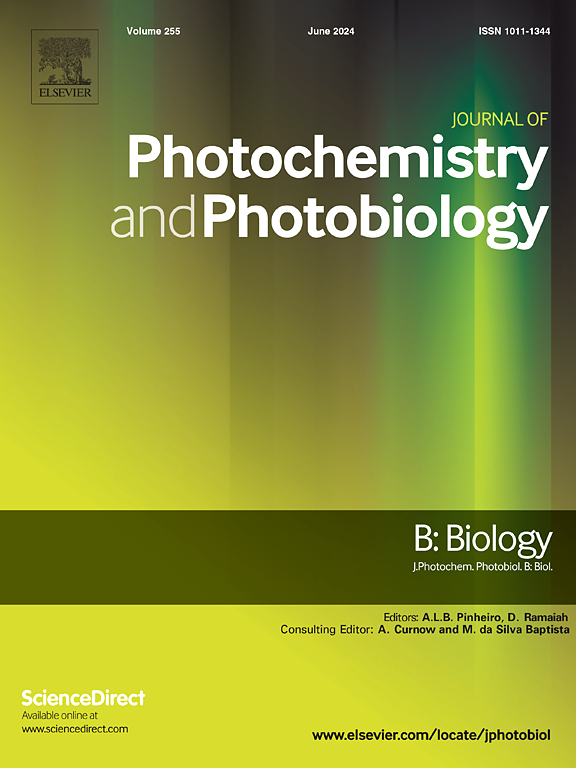Evaluating photosystem II efficiency in Parachlorella kessleri under atrazine exposure using chlorophyll a fluorescence analysis
IF 3.7
2区 生物学
Q2 BIOCHEMISTRY & MOLECULAR BIOLOGY
Journal of photochemistry and photobiology. B, Biology
Pub Date : 2025-04-23
DOI:10.1016/j.jphotobiol.2025.113167
引用次数: 0
Abstract
This study aims to evaluate the toxicity of Atrazine on freshwater algae by employing spectroscopic analysis (specifically the F683/F730 ratio) and photosynthetic parameters (Fv/Fm, Fv/F0, ФC, ФPSII, qP, and UQF) as bioindicators. The unicellular alga Parachlorella kessleri was selected for this investigation. Cells of Parachlorella kessleri were cultivated under axenic conditions in Bold's Basal Medium (BBM) and subsequently exposed to various concentrations of Atrazine (260, 520, and 1040 μg/L) for three distinct exposure durations (1, 60, and 360 min). Reflectance, transmittance, basal steady-state emission spectra, and variable chlorophyll-a fluorescence were recorded and analyzed for both control and treated algae groups. The results demonstrated that Atrazine inhibits electron transport in the photosynthetic chain of Parachlorella kessleri, leading to a marked decline in photosynthetic efficiency. The absorbed light energy was predominantly dissipated via the physical de-excitation pathway (ΦC), while regulated heat dissipation remained minimal—even in the absence of the herbicide—suggesting a possible deficiency in the PGR5-dependent photoprotective pathway. Among the tested fluorescence parameters, ΦPSII, derived from Kautsky kinetics, proved to be the most sensitive to Atrazine exposure, highlighting its potential use in algae-based biosensors for herbicide detection in aquatic environments. Although the OJIP method provided a faster response and detected abrupt changes in relative chlorophyll fluorescence (VOP), these changes did not correlate with herbicide concentration. Steady-state fluorescence, especially when corrected for inner filter effects, may offer a complementary, non-invasive tool for monitoring aquatic stressors. However, anomalous responses at high herbicide concentrations indicated the need for further validation under varied conditions.

利用叶绿素a荧光分析评价阿特拉津暴露下的克氏副球藻光系统II效率
本研究旨在通过光谱分析(特别是F683/F730比值)和光合参数(Fv/Fm、Fv/F0、ФC、ФPSII、qP和UQF)作为生物指标,评价阿特拉津对淡水藻类的毒性。本研究选用单细胞藻类伞藻(Parachlorella kessleri)。在Bold’s basic Medium (BBM)的无菌条件下培养kessleri副伞菌细胞,然后将其暴露于不同浓度的阿特拉嗪(260、520和1040 μg/L)中,持续3个不同的暴露时间(1,60和360 min)。记录和分析对照和处理藻类组的反射率、透射率、基本稳态发射光谱和可变叶绿素-a荧光。结果表明,阿特拉津抑制了kessleri副伞藻光合链中的电子传递,导致光合效率明显下降。吸收的光能主要通过物理去激发途径耗散(ΦC),而即使在没有除草剂的情况下,调节的散热仍然很小,这表明pgr5依赖性光保护途径可能存在缺陷。在测试的荧光参数中,来自考茨基动力学的ΦPSII被证明对阿特拉津暴露最敏感,这突出了它在水生环境中用于除草剂检测的藻类生物传感器中的潜在应用。虽然OJIP方法提供了更快的响应,并检测到相对叶绿素荧光(VOP)的突变,但这些变化与除草剂浓度无关。稳态荧光,特别是当校正内部过滤效应时,可以为监测水生应激源提供补充的非侵入性工具。然而,在高除草剂浓度下的异常反应表明需要在不同条件下进一步验证。
本文章由计算机程序翻译,如有差异,请以英文原文为准。
求助全文
约1分钟内获得全文
求助全文
来源期刊
CiteScore
12.10
自引率
1.90%
发文量
161
审稿时长
37 days
期刊介绍:
The Journal of Photochemistry and Photobiology B: Biology provides a forum for the publication of papers relating to the various aspects of photobiology, as well as a means for communication in this multidisciplinary field.
The scope includes:
- Bioluminescence
- Chronobiology
- DNA repair
- Environmental photobiology
- Nanotechnology in photobiology
- Photocarcinogenesis
- Photochemistry of biomolecules
- Photodynamic therapy
- Photomedicine
- Photomorphogenesis
- Photomovement
- Photoreception
- Photosensitization
- Photosynthesis
- Phototechnology
- Spectroscopy of biological systems
- UV and visible radiation effects and vision.

 求助内容:
求助内容: 应助结果提醒方式:
应助结果提醒方式:


